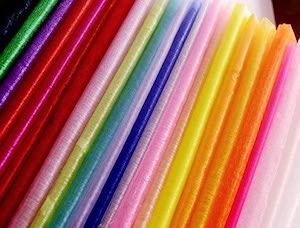Sheer fabrics are delicate and oh so beautiful. They are largely associated with wedding veils, but they can be used in many different ways. People often wonder about the differences between the various types. Unless you are a total fabric aficionado, this is completely understandable.
There are a lot of similarities between sheer fabrics so it is easy to get a bit confused. Tulle and organza are so much alike, how do you tell them apart?
What is the difference between tulle and organza? The main difference between tulle and organza is stiffness and elasticity. Tulle is stretchier and organza is stiffer. Other than that, they are quite similar and can be used in similar ways. Both are commonly used to make puffy clothing items like ballet tutus.
Let’s take a close look at each one and find out what the difference is between tulle and organza. In the end, maybe we will see one as better than the other. Or maybe we will see the differences, yet find them equal for their own special properties. Maybe one is better in some cases while the other excels in other areas.
The Difference Between Tulle and Organza
One thing all sheer fabrics have in common is that they are extremely delicate and need to be sewn with a machine capable of handling them with care. Learn about these fabrics so you will know how to use them to their fullest advantage when creating things so that your projects come out looking fabulous.
What is Tulle?
Tulle, commonly referred to as silk mesh, is a super sheer fabric that looks like tiny netting. This mesh is made from woven or knit silk or silk blends. The most common uses for tulle are wedding veils, trim or overlay, puffy skirts and petticoats. Tulle has considerable elasticity and great draping abilities.
This delicate fabric is named for the city of Tulle, France, where it was first created. This beautiful and versatile fabric originally became associated with weddings when Queen Victoria (famous for introducing the most bizarre, yet widely adopted practices) used it to create her bridal gown in 1840.
Tulle is a blended fabric. It ranges from very soft (made of cotton or silk) to very stiff (a polyester blend).
Tulle is quite stretchy, which makes sewing it very tricky. If you have the time and patience, hand sewing is highly recommended.
Tulle is available in every color of the rainbow to suit any fashion or decorating project. Keep in mind, most blends are quite scratchy, that is why most of today’s uses for the fabric are on outerwear such as hat trim, lingerie, tutus, window treatments, and floral adornments.
Tulle is the best choice for a puffy look since it’s ethereal and very sheer. It is widely used for veils, skirts, dress overlays and petticoats.
What is Organza?
Organza is a lightweight and nearly transparent fabric made from silk, polyester or nylon. Dresses made with this material don’t have much flow. However, it is very smooth and shiny and has a stiffer drape than tulle.
Organza is quite stiff because of the way it is woven. It feels smooth and looks shiny.
In the past, organza was made exclusively from silk. This changed with the advent of completely synthetic fabrics like nylon and polyester. These inventions made it possible to create this fabric from other base materials.
The word “organza” is derived from “organzine,” which, refers to any type of silk thread made by twist spinning the fibers.
Like most silk based fabrics, organza originated in the Silk Road area in East Asia. However, the words “organza” and “organzine” do not come from any Chinese words, but rather from the Turkestan town of Urgang, which was home to one of the most popular silk markets of the ancient world.
Westerners during the Middle Ages adapted the word “Urgang” and various variations of the words “organza” and “organzine” became terms used to refer to the spinning twisting method used to make the threads in this fabric.
Since organza is so fine and delicate, it is very easily damaged. You need to be very careful when wearing any fine mesh like organza and tulle. Garments can easily get caught up all sorts of snags.
When transporting organza, make sure to wrap it tightly in protective coverings. Keep them covered when in storage.
Because of its incredibly delicate nature, organza can’t be washed in a washing machine. It is necessary to wash organza by hand. Many people that own organza or tulle garments prefer to have them dry cleaned.
Organza is available in many colors and a popular choice for gowns and wedding dresses, especially the trim, accents or embellishments. It is also commonly used as a lining under other lightweight fabrics that need more body and support.
The fabric isn’t stretchy, so it easier to iron and less likely to be damaged by heat or water from an iron.
The biggest challenge of working with organza has to do with using it appropriately. It might be tempting to make all sorts of garments with this beautiful fabric, but keep in mind that it is quite stiff and wrinkles easily.
A good use for this fabric is decorating. It makes wonderful pew bows, floral arrangements, and chair sashes. It is also a great choice for window dressings and table cloths. The large selection of color choices makes it ideal for any décor. You are sure to find the perfect shade to match your color scheme.
Conclusion
Organza and tulle are both plain weave fabrics. This means that both the weft and the warp threads, which are the lengthwise and widthwise threads that are woven together during the weaving process of making fabric.
Because these fabrics are super lightweight, the quality of the fabric is measured by the number of holes per inch (HPI) instead of the thread count.
You get this measurement by counting the number of holes in every square inch of these fabrics. The more holes per square inch, the higher the rating, which means the higher the quality of the fabrics.


